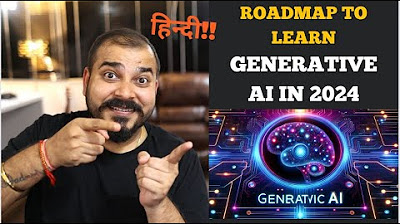Simplifying Generative AI : Explaining Tokens, Parameters, Context Windows and more.
Summary
TLDRThis video script delves into the world of generative AI, explaining the complex concepts behind large language models (LLMs) in an accessible way. It covers the basics of LLMs, tokens, parameters, context windows, and fine-tuning, illustrating their application in real-world AI. The script also explores popular models like GPT and Gemini, and the importance of prompt engineering to harness AI's full potential, providing insights into the ongoing AI revolution and its impact on various industries.
Takeaways
- 🧠 Generative AI is a hot topic across various industries, with concerns about job replacement and sector disruption, and is increasingly embedded in products and startups.
- 📚 Large Language Models (LLMs) are AI models trained with vast amounts of data, capable of generating human-like responses, and are compared to a librarian who has read every book in the world.
- 🔠 Tokens are the basic units of input and output in LLMs, helping the model understand and generate text more effectively, and are also the basis for how companies charge for model usage.
- 🔧 Parameters are the rules the model learns during training, determining how input data is transformed into output predictions, with more parameters generally leading to better performance.
- 🗨️ Context window refers to the amount of information the model can consider at once, with larger windows allowing for more coherent and relevant responses.
- 🛠️ Fine-tuning is the process of improving a pre-trained model's performance for specific tasks or domains by training it with custom, private data.
- 🚀 Open AI, Google, and Meta are major players in the AI space, with Open AI being one of the pioneers, releasing models like GPT-3, GPT 3.5, and GPT-4 with increasing capabilities.
- 🌐 GPT-4 stands out for being multimodal, accepting text or image inputs and outputting text or voice, and is more efficient and cost-effective than its predecessors.
- 🔄 Prompt Engineering is crucial for getting the best results from generative AI models, involving phrasing questions properly and asking for the right responses.
- 📈 Google's Gemini models are similar to Open AI's but have different specifications, and Google also offers open-source models for quick training without starting from scratch.
- 🔑 Understanding the terms and concepts related to LLMs is essential for leveraging their full potential in various applications, as covered in the video.
Q & A
What is the primary focus of the video script?
-The video script focuses on explaining the concepts and terminology related to large language models (LLMs), their capabilities, and how they are being integrated into various industries and products.
What is a large language model (LLM)?
-A large language model (LLM) is an AI model that has been trained with vast amounts of data, enabling it to generate human-like responses based on the input it receives.
What are some examples of popular large language models mentioned in the script?
-Some examples of popular large language models mentioned are GPT 3.5 from Open AI, Gemini from Google, and Lama 3 from Meta.
What is the significance of tokens in the context of LLMs?
-Tokens are the basic unit of input and output in a language model. They represent chunks of text that the model processes to understand and generate responses effectively.
How do parameters influence an LLM's performance?
-Parameters are the rules the model learns during training. They determine how input data is transformed into output predictions, with more parameters generally leading to better understanding and performance.
What is the purpose of a context window in LLMs?
-The context window represents the amount of information the model can consider at once, allowing it to remember more of the conversation and make its responses coherent and relevant.
What is fine-tuning in the context of AI models?
-Fine-tuning is the process of improving the performance of a pre-trained model for specific tasks or domains by training it with custom, private data related to those tasks or domains.
Why is prompt engineering important when interacting with LLMs?
-Prompt engineering is important because it involves learning how to ask the models questions that generate the best results, ensuring that responses are not generic and are tailored to the user's needs.
What is the difference between GPT 3 and GPT 3.5 in terms of token size?
-GPT 3 has a max token size of 4,097 tokens, while GPT 3.5 turbo can handle 16,384 tokens, which is four times more than GPT 3.
How does GPT 4 differ from its predecessors in terms of capabilities?
-GPT 4 is capable of handling 32,768 tokens, has a higher context window, and is multimodal, meaning it can accept text or image inputs and output text or voice.
What is the role of the RISE framework in prompt engineering?
-The RISE framework is a popular method in prompt engineering that involves giving the model a role, inputs, steps to take, and expectations, which helps in generating more targeted and specific responses.
Outlines

Esta sección está disponible solo para usuarios con suscripción. Por favor, mejora tu plan para acceder a esta parte.
Mejorar ahoraMindmap

Esta sección está disponible solo para usuarios con suscripción. Por favor, mejora tu plan para acceder a esta parte.
Mejorar ahoraKeywords

Esta sección está disponible solo para usuarios con suscripción. Por favor, mejora tu plan para acceder a esta parte.
Mejorar ahoraHighlights

Esta sección está disponible solo para usuarios con suscripción. Por favor, mejora tu plan para acceder a esta parte.
Mejorar ahoraTranscripts

Esta sección está disponible solo para usuarios con suscripción. Por favor, mejora tu plan para acceder a esta parte.
Mejorar ahoraVer Más Videos Relacionados

Google’s AI Course for Beginners (in 10 minutes)!

How does ChatGPT work? Explained by Deep-Fake Ryan Gosling.

Roadmap to Learn Generative AI(LLM's) In 2024-Krish Naik Hindi #generativeai

Generative AI Vs Agentic AI Vs AI Agents

Large Language Models explained briefly

Introduction to Large Language Models
5.0 / 5 (0 votes)
